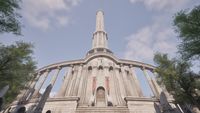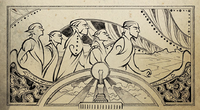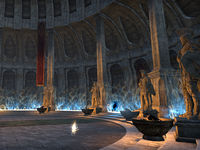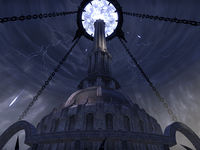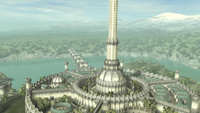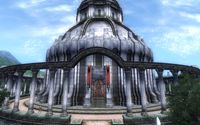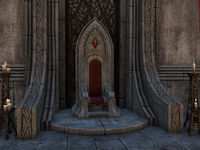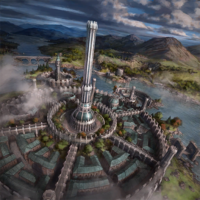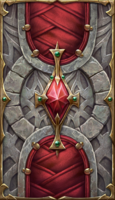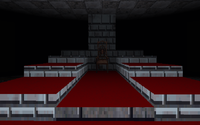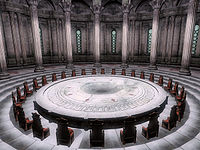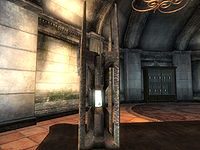Lore:White-Gold Tower
| White-Gold Tower | |
|---|---|
| Type | Tower |
| Continent | Tamriel |
| Province | Cyrodiil |
| Region | Heartlands (City Isle) |
| Settlement | Imperial City |
| Appears in | Arena, Daggerfall, Oblivion, ESO, Legends |
The White-Gold Tower (sometimes White Gold Tower),[1] also called the Imperial Palace, White-Stone Tower or simply White-Gold,[2][3][4] is the enormous central spire of the Imperial City, located in the heart of the Palace District, Green Emperor Way.[5]
White-Gold was built in emulation of the Adamantine Tower,[6] the oldest known structure on Tamriel.[7] Like the other Towers of Nirn, some speculate that White-Gold Tower wields the power necessary to keep Mundus from dissolving back into Oblivion.[8]:123[UOL 1]
History[edit]
The tower was built by the earliest Aldmeri migrants to Cyrodiil in the middle Merethic Era and was the center of the region occupied by their descendants, the Ayleids.[9][10] The tower was originally called the Temple of the Ancestors[11] (known to the Nedes as the Citadel),[12] and was home to the Ten Ancestors, a set of Ayleid statues made from meteoric iron and glass.[11] The distance between the Ayleids' lands and those of their theoretical overlords led to the establishment of White-Gold Tower as an independent city-state in 1E 0;[9] a state that lasted until Alessia overthrew Ayleid rule in 243.[13][14] The Ten Ancestors were removed from the temple before its sacking and were dispersed among several Ayleid cities.[11]
During the reign of the Ayleid Empire, at the time of Saint Alessia, Umaril the Unfeathered reigned as liege-lord of the other Ayleid sorcerer-kings and holder of the Cyrodilic throne, known as the "Cyrodiil",[15],[16] from the throne room of the Temple of the Ancestors, a right he was bestowed thanks to his incredible power and status as the most favored champion of the Daedric Prince Meridia.[17]
In 1E 243, the Alessian Slave Rebellion came to a head, and the armies of man, led by Morihaus, attacked and took the White-Gold Tower.[12][18] According to the official histories of the Alessian Empire, when the tower was captured, all the Ayleids' relics of arcane power were taken and destroyed. However some insisted that an unknown Ayleid king escaped with the chief artifacts, which eventually found themselves a home in the Reliquary of Stars in Valenwood.[19][20]
Under the human-dominated Empires, it served as the Imperial Palace and as a defining symbol of those Empires. Some scholars even suggest the tower itself changed Cyrodiil from a subtropical jungle into a realm of temperate forests and fields in order to meet the needs and wishes of its new human masters.[21] The tower hosted the vaults and libraries of the Moth Priesthood. It can be seen from all over the Imperial City and the surrounding countryside. Underneath the tower and in the vast Imperial City Sewers is the Barathrum Centrata, the centralmost point of the sewer system and foundation of the White-Gold Tower.[22]
Second Era[edit]
In 2E 582, the Ruby Throne was located on the ground floor.[23] By 3E 433, however, the ground floor was the location of the Elder Council chambers.[5]
When the Planemeld began, the largest Dark Anchor opened above the skies of the Imperial City, intent on pulling the White-Gold Tower, a metaphysical focus so important it had the potential to pull all of Tamriel in with it once taken, into Coldharbour.[24]
After the Great Shackle was destroyed and Molag Bal was wounded by an Amulet of Kings-empowered Vestige,[25][26][27] a final attempt to restart the Planemeld was made.[UOL 2] Molag Bal sent a Xivkyn called Molag Kena to pose as the seemingly-deceased Empress Regent Clivia Tharn and "retake" the White-Gold Tower. In truth, Kena sought an Elder Scroll within the Tower and planned to use its power to initiate the "Planemeld Obverse" and begin simultaneously pulling Coldharbour into Nirn. However, a moth priestess called Terran Arminus had read the scroll before the Daedric occupation of the Imperial City, and had learned that she would need aid in order to save the scroll. This aid arrived in the form of a group of Undaunted, and the prophesied Soulless One, who helped Clivia's entourage ascend the shattered reality of the Tower's upper levels before being betrayed by the imposter. These heroes defeated Molag Kena atop the Tower before she could fully complete the ritual, and in the process destroyed the Anchor above the city.[28][29]
Around the same time, the fragments of the Staff of Towers were located by the Psijic Order. The pieces were scattered all around Tamriel: the Adamantine and White-Gold fragments in High Rock, the Orichalc and Snow fragments in Hammerfell, the Walk-Brass and Red fragments in Morrowind, the Crystal fragment in Black Marsh, and the Green-Sap fragment in Valenwood. A member of the Psijic Order, the Vestige, sealed the time breaches the Staff had created around the continent with the aid of the Augur of the Obscure, which allowed them to locate and retrieve the fragments. The reassembled Staff was subsequently stolen by Josajeh, a member of the Order who wanted to use the staff to alter time to reverse damage done to her family in the past, threatening to envelop Aurbis in a new Dragon Break or even unravel time entirely. The Vestige tracked Josajeh to the White-Gold Tower's Time-Lost Throne Room, a location detached from regular time and space, where she intended to use an Ayleid ritual that could, when used alongside the Tower and Staff, alter time. The Order's agent bested Josajeh and her alternate timeline selves that had entered the chamber through temporal rifts, and reclaimed the artifact for the Order.[30][31][32]
Third Era[edit]
Circa 3E 433, a member of the Thieves Guild infiltrated the White-Gold Tower and stole an Elder Scroll from the library of the Moth Priests. The theft involved entering the basement of the White-Gold Tower, and activating a relic known as the Glass of Time, use of which revealed the path to the Old Way, the Ayleid section of the Imperial City's undeground.[33][34]
Fourth Era[edit]
Around 4E 48, the Daedric city of Umbriel appeared in the skies of Tamriel, starting the Umbriel Crisis.[35]
Vuhon and Umbra, who had become one, intended to have Umbriel reach the White-Gold Tower, in order to use its power to render Umbra truly separate from Vile rather than a rogue aspect, thereby also freeing Umbriel itself. However, their plans were foiled due to a pact Vile had made with Prince Attrebus Mede and the mage Sul. In the end, Vile was able to regain the power he lost due to the crisis, seemingly reclaiming the spirit of Umbra and absorbing the thousands of souls within Umbriel's Ingenium in the process, but he and Umbriel were banished by the Umbriel-Hist before he carry out his plan to unleash more chaos in Tamriel by allowing Umbriel to fall onto the Imperial City itself.[36]
During the Umbriel Crisis, Imperial minister Hierem planned to use the power of the White-Gold Tower to siphon the thousands of souls within Umbriel's Ingenium, as he believed their power would allow him to achieve Apotheosis and become a god. However, he was slain before he could make the attempt.[36]
As a Tower[edit]
White-Gold was built in open emulation of the Adamantine Tower,[6] the oldest known structure on Tamriel. Like the other Towers the elves built during the Merethic Era, it was built to "tell its own story", consisting of rules inscribed by Variorum Architects, thereby shaping reality within its domain. In addition, White-Gold was constructed to counteract the spiritual bleeding from Mundus since the Convention, serving as a point of reconnection between the mortal world and the divine.To this end, the Ayleids entered into a pact with the Daedric Princes to harvest castaway creatia from the Void. White-Gold's resemblance to Ada-Mantia gave it even greater power to alter reality than the other elven Towers and, because it serves as a mimicry of the Aurbic Wheel itself, it being meddled with could have disastrous consequences.[UOL 3][2][7] Indeed, some scholars believe that, were enough Tel Var Stones, used by the Ayleids as substitutes for the Zero Stone, to be removed from the Tower's walls, Creation could be undone and the Mundus could dissolve into Oblivion.[37] The Tower's role as a focus of mystical power meant that it being pulled into Oblivion during the Planemeld, could have resulted in the rest of Tamriel being pulled in with it.[38]
Thus the Imperial Throne Room at the base of the White-Gold Tower is one of the most important metaphysical foci in all of Mundus, so much so it could almost be said to exist adjacent to all time and space in Aedric creation.[39]. The White-Gold Tower itself is said to exist on a level beyond the physical, existing apart or detached from time.[32] The nature of the Tower and its Time-Lost Throne Room allows it to serve as a catalyst for the use of powerful Time Magic, with the Ayleids having invented a ritual that could rewrite time through the use of the Staff of Towers in conjuction with the Tower throne room. The ritual is highly dangerous, as it has the potential to create an "impossibly dense Aurbic gyre" of power that could create a new Dragon Break, or a catastrophe even worse than that.[32][40][31][41]
The White-Gold Tower's Stone was the Chim-el Adabal, the Amulet of Kings, said to have been formed from a drop of blood that fell from the Heart of Lorkhan as it sailed across Tamriel, which subsequently fell into an Ayleid Well and was crystallized by the magicka within, before being cut into a diamond shape by the elves.[2][42][43]
Gallery[edit]
Exterior[edit]
White-Gold Tower during the Planemeld
(ESO)The Imperial Palace during the Imperial Simulacrum
(Arena)White-Gold Tower, 3E 433
(Oblivion introduction)White-Gold Tower, 4E 175
(Legends)
Interior[edit]
The Ruby Throne, 2E 582
(ESO)The Ruby Throne during the Three Banners War
(Legends)Elder Council Chambers
(Oblivion)One of the Ten Ancestors
(Oblivion)
Notes[edit]
- Tel Var Stones are believed to be pieces of the tower.
- The Imperial Palace is the most recurring location in The Elder Scrolls:
- It first appears as the final dungeon in Arena.
- The Introduction Scene to Daggerfall features a brief appearance of the Emperor's throne room.
- The modern iteration as the White-Gold Tower makes its first appearance in Oblivion.
- A main character visits their father, the emperor, in the Imperial Palace during The Infernal City, with the Tower itself appearing on the cover of Lord of Souls.
- The White-Gold Tower can be seen from the southern-most border with Cyrodiil in Skyrim.
- Along with the Imperial City, it is depicted in various different illustrations throughout The Improved Emperor's Guide to Tamriel.
- Several different iterations of the Tower appear in ESO, first as a dungeon, and three different versions from alternate realities.
- The White-Gold Tower appears during The Forgotten Hero story, as well as a playing card, in Legends.
See Also[edit]
- For game-specific information, see the Arena, Daggerfall, Oblivion, Elder Scrolls Online
 , and Legends articles.
, and Legends articles.
Books[edit]
- Subtropical Cyrodiil: A Speculation by Lady Cinnabar of Taneth — Thoughts on the climate of Cyrodiil and its relationship to the White-Gold Tower
References[edit]
- ^ Cherim's Heart of Anequina — Livillus Perus, Professor at the Imperial University
- ^ a b c Aurbic Enigma 4: The Elden Tree — Beredalmo the Signifier
- ^ Guide to the Imperial City — Alessia Ottus
- ^ Red Eagle's Song — Varana Tappo, Imperial Scribe serving the Longhouse Emperors
- ^ a b The Imperial Palace in Oblivion
- ^ a b Beacon of Tower Zero furnishing name, appearance and Codex entries in ESO
- ^ a b Pocket Guide to the Empire, 1st Edition: High Rock — Imperial Geographical Society, 2E 864
- ^ The Infernal City — Greg Keyes
- ^ a b Before the Ages of Man — Aicantar of Shimerene
- ^ Pocket Guide to the Empire, 1st Edition: Cyrodiil — Imperial Geographical Society, 2E 864
- ^ a b c Umbacano's dialogue in Oblivion
- ^ a b Varieties of Faith... — Brother Mikhael Karkuxor of the Imperial College
- ^ The Last King of the Ayleids — Herminia Cinna
- ^ Shezarr and the Divines — Faustillus Junius
- ^ The Origin of Cyrus! — Michael Kirkbride
- ^ Umaril is Undone — Thadoril
- ^ Meet the Character - King Narilmor — Tjurhane Fyrre
- ^ Pocket Guide to the Empire, 3rd Edition: All the Eras of Man, A Comprehensive History of our History — Imperial Geographical Society, 3E 432
- ^ Reliquary of Stars loading screen in ESO
- ^ Remnants of Cyrod
- ^ Subtropical Cyrodiil: A Speculation — Lady Cinnabar of Taneth
- ^ Imperial Architect's Correspondence — Mycaelis Julus
- ^ White-Gold Tower in ESO
- ^ White-Gold Tower loading screen in ESO
- ^ Events of Vanus Unleashed in ESO
- ^ Events of The Final Assault in ESO
- ^ Events of God of Schemes in ESO
- ^ Planemeld Obverse quest in ESO
- ^ Sister Terran Arminus' dialogue in ESO
- ^ The Psijic Order questline in ESO: Summerset
- ^ a b Augur of the Obscure's dialogue in ESO
- ^ a b c Loremaster Celarus' dialogue in ESO: Summerset
- ^ The Ultimate Heist quest in Oblivion
- ^ The Gray Fox's dialogue in Oblivion
- ^ The Infernal City — Greg Keyes
- ^ a b Lord of Souls — Greg Keyes
- ^ Phrastus of Elinhir's dialogue in ESO
- ^ White-Gold Tower loading scren in ESO
- ^ Time-Lost Throne Room loading screen in ESO
- ^ Josajeh's dialogue in ESO: Summerset.
- ^ Events of The Towers' Fall in ESO
- ^ The Chim-el Adabal — Mannimarco
- ^ Chim-el Adabal: A Ballad
Note: The following references are considered to be unofficial sources. They are included to round off this article and may not be authoritative or conclusive.
- ^ Nu-Mantia Intercept — Nu-Hatta
- ^ Temple District background in the Future of The Elder Scrolls Online Panel from QuakeCon 2014
- ^ Nu-Mantia Intercept — Nu-Hatta, The Imperial Library
